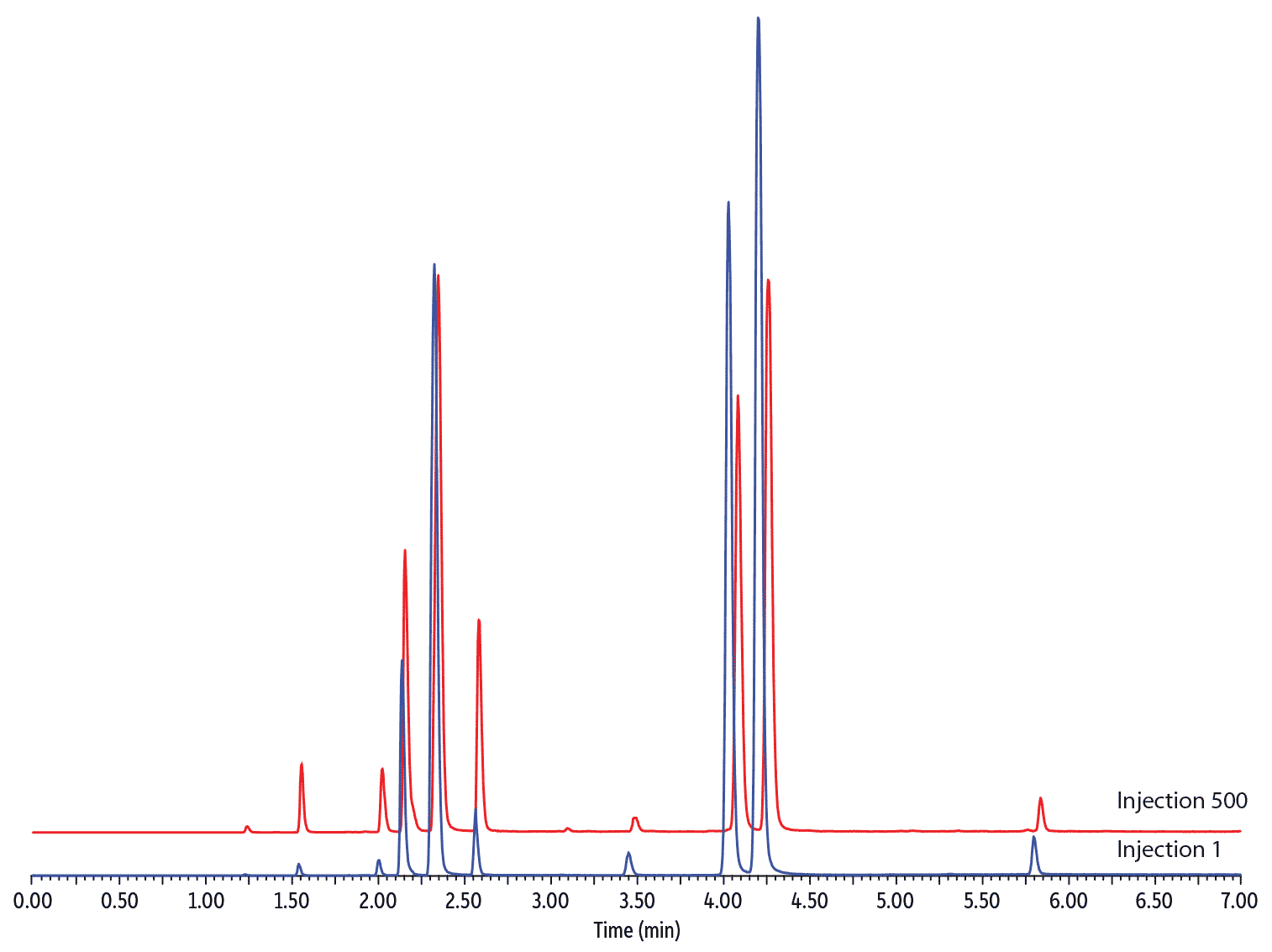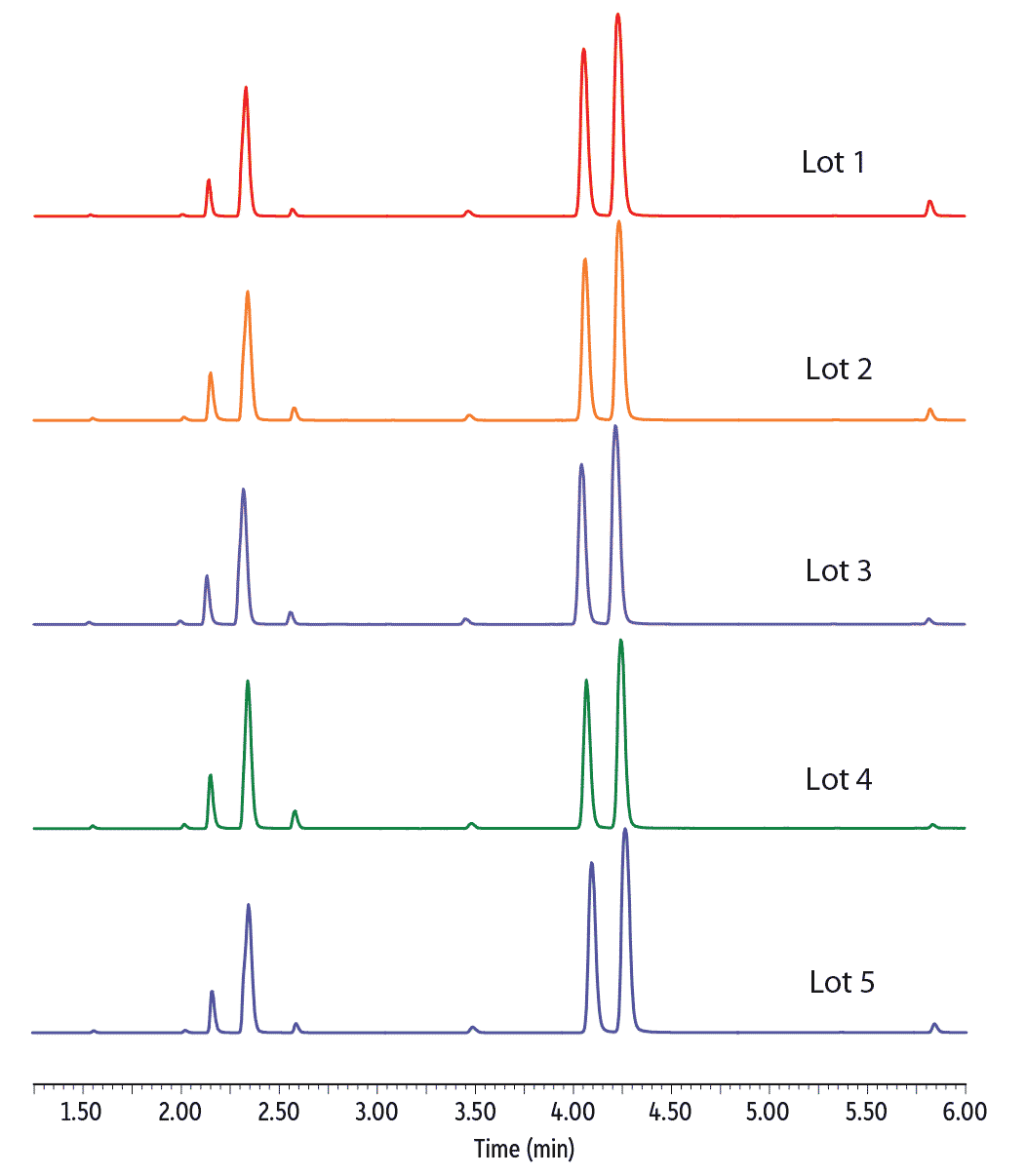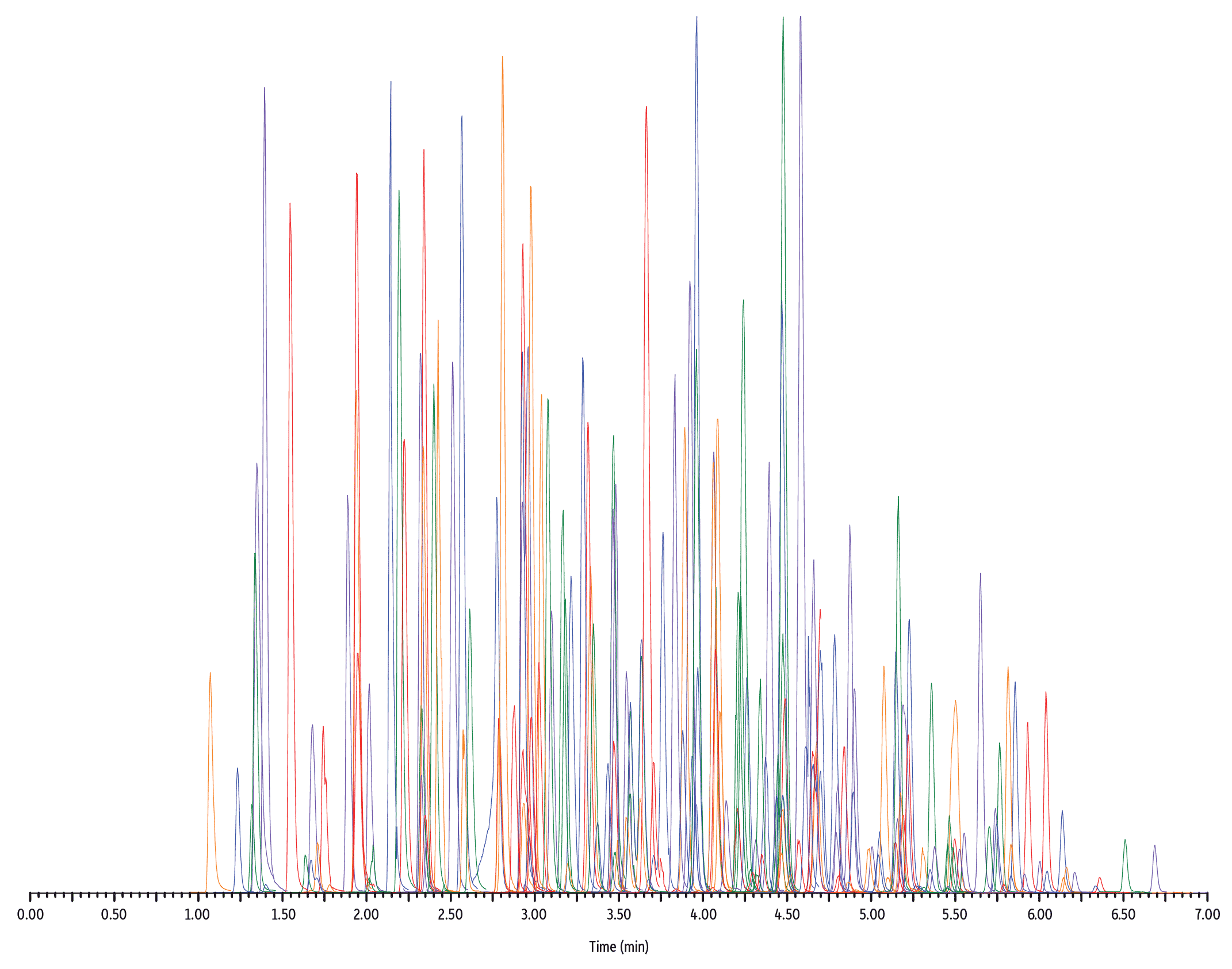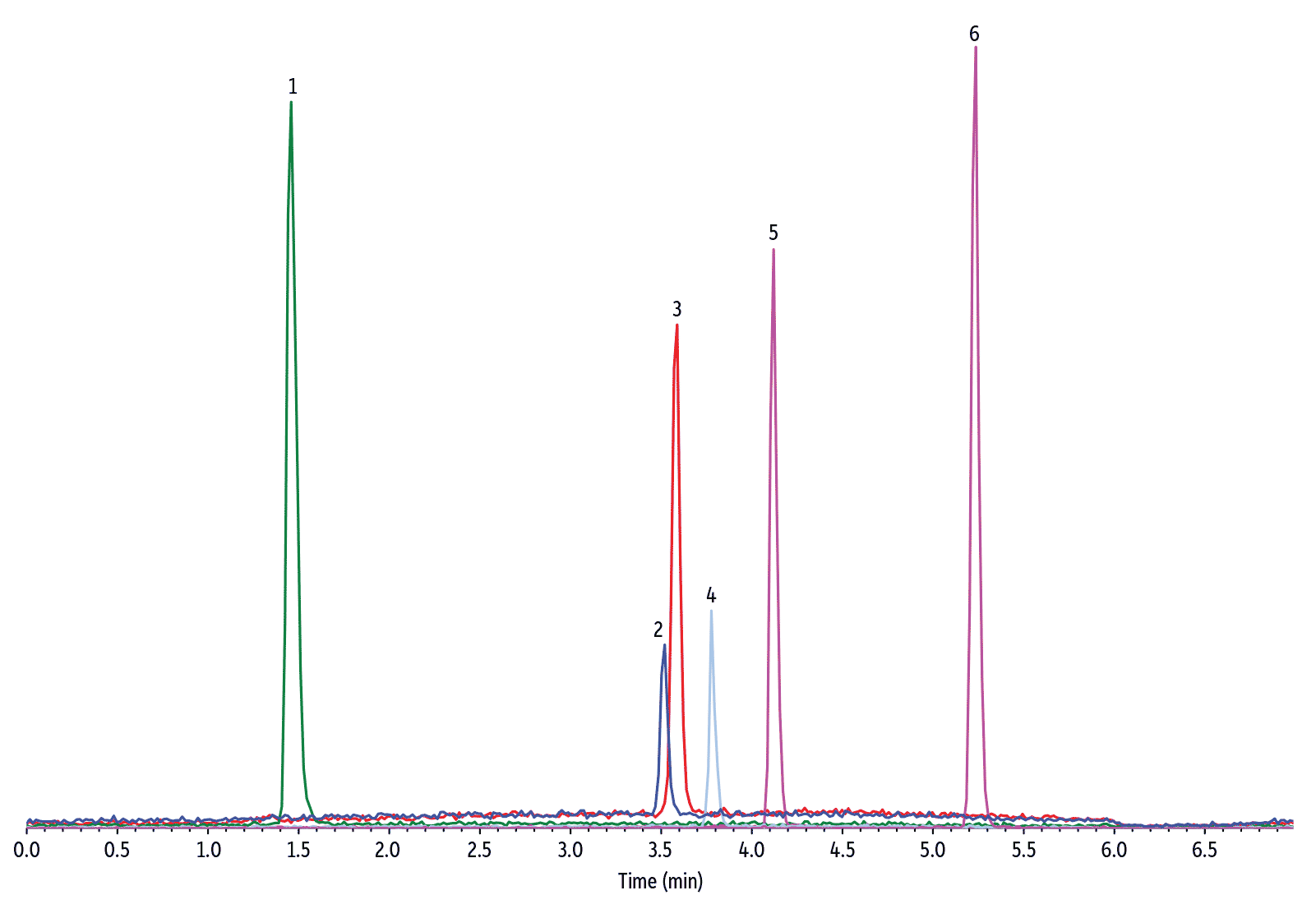Raptor ARC-18: Ahead of the Curve for Large, Multiclass Lists by Mass Spec
With Raptor LC columns, Restek chemists became the first to combine the speed of 2.7 and 5 μm superficially porous particles (also known as SPP or “core-shell” particles) with the resolution of highly selective USLC technology, improving separations and speeding up analysis times with standard HPLC instruments. Raptor then evolved to bring that same improved speed, efficiency, and selectivity to UHPLC analyses by offering 1.8 μm particle columns. Learn more about Raptor LC columns at www.restek.com/raptor
The birth of Restek’s Raptor SPP LC column line began with the innovative Biphenyl phase, but it quickly grew to include a new Restek phase: the ARC-18. Designed and intended specifically for use on LC-MS/MS systems, the Raptor ARC-18 column features a well-balanced retention profile without the drawbacks of using an ordinary C18 in the harsh, acidic mobile phases needed for mass spectrometry (MS). Even after extended use in these low-pH (≤ 2.0) conditions, the sterically protected ARC-18 offers consistent retention, peak shape, and response for charged bases, neutral acids, small polar compounds, and more.
For the rapid analysis of large, multiclass assays by LC-MS/MS, the acid-resistant Raptor ARC-18 truly is ahead of the curve.
Column Description: |
|||
Column Interaction Profile:Defining Solute Interactions:
Complementary Solute Interaction:
|
Recommended Usage:pH Range: 1.0–8.0 Properties:
Switch to an ARC-18 when:
Solute Retention Profile:Target Analyte Structures:
Target Analyte Functionalities:
|
||
A Proprietary Bonded Phase Born for LC-MS/MS
The Raptor ARC-18 column was designed to stand up to even the harshest acidic MS conditions. It utilizes a proprietary bonding procedure that arranges our sterically protected ligand to resist acid hydrolysis, which reduces phase degradation and bleed. This cutting-edge column lets you increase ionization efficiency and boost sensitivity in your mass spec by using low-pH mobile phases—without the fear of retention drift over time. ARC-18 columns maintain a stable retention profile (Figure 1) in mobile phases well under pH 2.0.
Figure 1: Steric protection helps the Raptor ARC-18 column endure low-pH MS mobile phases without sacrificing retention.
The Standard for Reproducibility for SPP Core-Shell LC Columns
To keep your productivity high and your lab expenses low, Raptor ARC-18 columns must produce exceptional selectivity and fast analysis times not just once, but every time. Ruggedness and repeatability are essential, which is why from the silica and the bonding technique, to the packing process and upgraded hardware, every decision that went into creating this column was made to ensure superlative reproducibility, from injection to injection (Figure 2) and from lot to lot (Figure 3). We also adopted new quality control (QC) specifications to guarantee the retention time stability you need for worry-free analyses.
One of the greatest advantages of an SPP column is the ability to operate at higher linear velocities without losing efficiency as you would with a conventional fully porous particle column. But, these higher velocities can also generate higher backpressures that rob you of performance. Like all Raptor columns, our ARC-18 can handle increased pressures and handle them longer than other manufacturers’ SPP columns, to help you achieve Selectivity Accelerated while offering outstanding reproducibility and maintaining efficiency—even in aggressive MS conditions.
Figure 2: Even after hundreds of injections with a highly acidic mobile phase like 0.2% formic acid, a Raptor ARC-18 column will provide consistent, reliable data.
After 500 injections, pesticide compounds are well within narrow, 15-second MRM windows!

| Column | Raptor™ ARC-18 (cat.# 9314A12) | ||||||||||||||||||||||||||||||||
|---|---|---|---|---|---|---|---|---|---|---|---|---|---|---|---|---|---|---|---|---|---|---|---|---|---|---|---|---|---|---|---|---|---|
| Dimensions: | 100 mm x 2.1 mm ID | ||||||||||||||||||||||||||||||||
| Particle Size: | 2.7 µm | ||||||||||||||||||||||||||||||||
| Temp.: | 50 °C | ||||||||||||||||||||||||||||||||
| Standard/Sample | LC multiresidue pesticide standard #1 (cat.# 31972) | ||||||||||||||||||||||||||||||||
| Diluent: | Water | ||||||||||||||||||||||||||||||||
| Conc.: | 20 ng/mL | ||||||||||||||||||||||||||||||||
| Inj. Vol.: | 5 µL | ||||||||||||||||||||||||||||||||
| Mobile Phase | |||||||||||||||||||||||||||||||||
| A: | Water + 2 mM ammonium formate + 0.2% formic acid | ||||||||||||||||||||||||||||||||
| B: | Methanol + 2 mM ammonium formate + 0.2% formic acid | ||||||||||||||||||||||||||||||||
|
| Detector | Waters Xevo TQ-S |
|---|---|
| Ion Source: | Waters Zspray™ ESI |
| Ion Mode: | ESI+ |
| Mode: | MRM |
| Instrument | Waters ACQUITY UPLC I-Class |
Figure 3: From one lot to the next, every Raptor ARC-18 column you purchase will perform the same.
Excellent lot-to-lot reproducibility helps ensure longevity for critical workflows.

| Column | Raptor™ ARC-18 (cat.# 9314A12) | ||||||||||||||||||||||||||||||||
|---|---|---|---|---|---|---|---|---|---|---|---|---|---|---|---|---|---|---|---|---|---|---|---|---|---|---|---|---|---|---|---|---|---|
| Dimensions: | 100 mm x 2.1 mm ID | ||||||||||||||||||||||||||||||||
| Particle Size: | 2.7 µm | ||||||||||||||||||||||||||||||||
| Temp.: | 50 °C | ||||||||||||||||||||||||||||||||
| Standard/Sample | LC multiresidue pesticide standard #1 (cat.# 31972) | ||||||||||||||||||||||||||||||||
| Diluent: | Water | ||||||||||||||||||||||||||||||||
| Conc.: | 20 ng/mL | ||||||||||||||||||||||||||||||||
| Inj. Vol.: | 5 µL | ||||||||||||||||||||||||||||||||
| Mobile Phase | |||||||||||||||||||||||||||||||||
| A: | Water + 2 mM ammonium formate + 0.2% formic acid | ||||||||||||||||||||||||||||||||
| B: | Methanol + 2 mM ammonium formate + 0.2% formic acid | ||||||||||||||||||||||||||||||||
| |||||||||||||||||||||||||||||||||
| Max Pressure: | 525 bar |
| Detector | Waters Xevo TQ-S |
|---|---|
| Ion Source: | Waters Zspray™ ESI |
| Ion Mode: | ESI+ |
| Mode: | MRM |
| Instrument | Waters ACQUITY UPLC I-Class |
Well-Balanced Retention to Quickly Separate Large, Multiclass Analyte Lists
In order to analyze large lists of compounds, especially across multiple classes, your column must be capable of spreading analytes out over the gradient to ensure accurate detector response and quantitation. In designing the Raptor ARC-18 column, we adjusted our bonding procedures to form an ideal ligand density that offers balanced retention for the rapid analysis of large, multiclass assays. As shown in Figure 4, even a 204-compound pesticide screen can be reliably completed in just 9.5 minutes. The Raptor ARC-18 column exhibits the balanced retention, selectivity, and performance needed for critical multiclass workflows in any industry or lab.
Figure 4: With its balanced retention profile, the Raptor ARC-18 column is ideally suited to analyze large, cross-class compound lists.
204 pesticides in just 9.5 minutes!
For a complete compound list, visit www.restek.com/multiresidue select the LC Multiresidue Pesticide Kit (cat.# 31971).

| Column | Raptor™ ARC-18 (cat.# 9314A12) | ||||||||||||||||||||||||||||||||
|---|---|---|---|---|---|---|---|---|---|---|---|---|---|---|---|---|---|---|---|---|---|---|---|---|---|---|---|---|---|---|---|---|---|
| Dimensions: | 100 mm x 2.1 mm ID | ||||||||||||||||||||||||||||||||
| Particle Size: | 2.7 µm | ||||||||||||||||||||||||||||||||
| Temp.: | 50 °C | ||||||||||||||||||||||||||||||||
| Standard/Sample | LC multiresidue pesticide kit (cat.# 31971) | ||||||||||||||||||||||||||||||||
| Diluent: | Water | ||||||||||||||||||||||||||||||||
| Conc.: | 20 ng/mL | ||||||||||||||||||||||||||||||||
| Inj. Vol.: | 5 µL | ||||||||||||||||||||||||||||||||
| Mobile Phase | |||||||||||||||||||||||||||||||||
| A: | Water + 2 mM ammonium formate + 0.2% formic acid | ||||||||||||||||||||||||||||||||
| B: | Methanol + 2 mM ammonium formate + 0.2% formic acid | ||||||||||||||||||||||||||||||||
| |||||||||||||||||||||||||||||||||
| Max Pressure: | 525 bar |
| Detector | Waters Xevo TQ-S |
|---|---|
| Ion Source: | Waters Zspray™ ESI |
| Ion Mode: | ESI+ |
| Mode: | MRM |
| Instrument | Waters ACQUITY UPLC I-Class |
| Notes | When combining a large number of compounds with different chemical functionalities, mix stability can be an issue. In formulating our LC multiresidue pesticide standard kit (cat.# 31971), we extensively studied the 204 compounds involved, then grouped them into as few mixes as possible while still ensuring maximum long-term stability and reliability. Several of these compounds are isomeric and separation of the isomers accounts for 216 peaks in the chromatogram compound list. For quantitative analysis, we recommend analyzing each mix separately to ensure accurate results for every compound. |
Speed Up Challenging Analyses with Simple Mobile Phases and Methods
From food safety to bioanalytical work, whether you use traditional HPLC or UHPLC instruments, we’re all looking to simplify setup while still getting reliable, reproducible data. Instead of wasting time and resources—and making your job harder in the process—you can greatly improve your productivity by selecting a better column for your existing instrumentation. By switching to a Raptor ARC-18 column for your LC-MS/MS analyses, you can increase your sample throughput and make your job easier by maintaining, or even improving, your data quality using simple mobile phases and method conditions on your existing instrumentation. Put the ARC-18 to work in your lab today to experience Selectivity Accelerated!
Cannabinoids Analysis Across Methods and Instruments
Whether your lab is performing cost-effective, low-solvent analyses or fast UHPLC for high-throughput, use Raptor ARC-18 columns to fully resolve 16 common cannabinoids across cannabis methods (Figure 5). Because of its compatibility with MS-friendly mobile phases, these UV methods can also be easily transferred to your mass spectrometer. And, since ARC-18 is a Raptor column, it will hold up to extended use without losing selectivity or performance.
Figure 5: All four potency methods produce excellent results—demonstrating ARC-18’s versatility.
| Method 1 | Method 2 | Method 3 | Method 4 | |
| Column dimensions | 150 x 4.6 mm, 2.7 μm | 150 x 3 mm, 2.7 μm | 150 x 2.1 mm, 2.7 μm | 100 x 3 mm, 1.8 μm |
| Flow | 1.5 mL/min | 1 mL/min | 0.4 mL/min | 1 mL/min |
| Injection volume | 5 μL | 2 μL | 2 μL | 1 μL |
| Run time* | 9 min | 6 min | 10 min | 4 min |
| Use/benefits | Standard HPLC | Fast HPLC | Solvent saver | Fast UHPLC |

| Peaks | tR (min) | Conc. (µg/mL) | |
|---|---|---|---|
| 1. | Cannabidivarinic acid (CBDVA) | 1.897 | 50 |
| 2. | Cannabidivarin (CBDV) | 2.121 | 50 |
| 3. | Cannabidiolic acid (CBDA) | 2.685 | 50 |
| 4. | Cannabigerolic acid (CBGA) | 2.860 | 50 |
| 5. | Cannabigerol (CBG) | 3.047 | 50 |
| 6. | Cannabidiol (CBD) | 3.217 | 50 |
| 7. | Tetrahydrocannabivarin (THCV) | 3.472 | 50 |
| 8. | Tetrahydrocannabivarinic acid (THCVA) | 4.416 | 50 |
| Peaks | tR (min) | Conc. (µg/mL) | |
|---|---|---|---|
| 9. | Cannabinol (CBN) | 4.794 | 50 |
| 10. | Cannabinolic acid (CBNA) | 5.661 | 50 |
| 11. | Δ9-Tetrahydrocannabinol (Δ9-THC) | 6.064 | 50 |
| 12. | Δ8-Tetrahydrocannabinol (Δ8-THC) | 6.275 | 50 |
| 13. | Cannabicyclol (CBL) | 7.228 | 50 |
| 14. | Cannabichromene (CBC) | 7.634 | 50 |
| 15. | δ-9-Tetrahydrocannabinolic acid-A (THCA-A) | 7.973 | 50 |
| 16. | Cannabichromenic acid (CBCA) | 8.992 | 50 |
| Column | |
|---|---|
| Temp.: | 30 °C |
| Standard/Sample | |
| Diluent: | 25:75 Water:acetonitrile |
| Mobile Phase | Water, 5 mM ammonium formate, 0.1% formic acid:Acetonitrile, 0.1% formic acid (25:75) |
| Flow: | 0.4-1.5 mL/min |
| Detector | UV/Vis @ 228 nm |
|---|---|
| Instrument | HPLC |
| Notes | Method 1 Column: Raptor ARC-18; 150 x 4.6 mm, 2.7 µm (cat.# 9314A65) Flow: 1.5 mL/min; isocratic, 9 min Injection volume: 5 µL Method 2 Column: Raptor ARC-18; 150 x 3 mm, 2.7 µm (cat.# 9314A6E) Flow: 1.0 mL/min; isocratic, 6 min Injection volume: 2 µL Method 3 Column: Raptor ARC-18; 150 x 2.1 mm, 2.7 µm (cat.# 9314A62) Flow: 0.4 mL/min; isocratic, 10 min Injection volume: 2 µL Method 4 Column: Raptor ARC-18; 100 x 3 mm, 1.8 µm (cat.# 931421E) Flow: 1.0 mL/min; isocratic, 4 min Injection volume: 1 µL |
Fat-Soluble Vitamins with Accelerated Run Times
Separating fat-soluble vitamins by LC can be time-consuming. The Raptor ARC-18 column, however, can analyze these difficult compounds using reversed-phased chromatography (RPC) in less time than traditional columns to increase productivity. The ARC-18 also stands up to the low-pH, MS-friendly mobile phases that promote ionization and fast separation while providing the balanced retention profile necessary for this important food safety workflow (Figure 6).
Figure 6: The ARC-18 makes quick work of fat-soluble vitamins A, D, E, and K by LC-MS/MS.

| Column | Raptor ARC-18 (cat.# 9314A12) | ||||||||||||||||||||||||
|---|---|---|---|---|---|---|---|---|---|---|---|---|---|---|---|---|---|---|---|---|---|---|---|---|---|
| Dimensions: | 100 mm x 2.1 mm ID | ||||||||||||||||||||||||
| Particle Size: | 2.7 µm | ||||||||||||||||||||||||
| Temp.: | 40 °C | ||||||||||||||||||||||||
| Standard/Sample | |||||||||||||||||||||||||
| Diluent: | Methanol | ||||||||||||||||||||||||
| Conc.: | 100 ng/mL | ||||||||||||||||||||||||
| Inj. Vol.: | 5 µL | ||||||||||||||||||||||||
| Mobile Phase | |||||||||||||||||||||||||
| A: | 0.1% Formic acid + 5 mM ammonium formate in water | ||||||||||||||||||||||||
| B: | 0.1% Formic acid + 5 mM ammonium formate in methanol | ||||||||||||||||||||||||
| |||||||||||||||||||||||||
| Max Pressure: | 190 bar |
| Detector | ABSCIEX API 4000 |
|---|---|
| Ion Source: | TurboIonSpray® |
| Ion Mode: | ESI+ |
| Mode: | MRM |
| Instrument | Shimadzu UFLCXR |
Toxic Substances in Agricultural Matrices Using LC
When it comes to analyzing toxic substances in agricultural matrices (e.g., aflatoxins in wheat), speed is of paramount importance. A Raptor ARC-18 column retains and separates these compounds with simple mobile phases—in a rapid time frame that maximizes your productivity (Figure 7).
Figure 7: The ARC-18 elutes four common aflatoxins in under 1.5 minutes with an overall cycle time of 2.5 minutes!

| Column | Raptor ARC-18 (cat.# 9314A5E) | ||||||||||||||||||||
|---|---|---|---|---|---|---|---|---|---|---|---|---|---|---|---|---|---|---|---|---|---|
| Dimensions: | 50 mm x 3.0 mm ID | ||||||||||||||||||||
| Particle Size: | 2.7 µm | ||||||||||||||||||||
| Temp.: | 45 °C | ||||||||||||||||||||
| Standard/Sample | |||||||||||||||||||||
| Diluent: | Acetonitrile:water (50:50) | ||||||||||||||||||||
| Conc.: | 100 ng/mL | ||||||||||||||||||||
| Inj. Vol.: | 10 µL | ||||||||||||||||||||
| Mobile Phase | |||||||||||||||||||||
| A: | 5 mM Ammonium formate + 0.1% formic acid in water | ||||||||||||||||||||
| B: | 0.1% Formic acid in methanol | ||||||||||||||||||||
|
| Detector | Applied Biosystems/MDS Sciex LC-MS/MS |
|---|---|
| Ion Source: | TurboIonSpray® |
| Ion Mode: | ESI+ |
| Instrument | Shimadzu UFLCXR |
Experience Selectivity Accelerated. Order the Raptor ARC-18 LC column today.
Want even better performance when analyzing mycotoxins and other metal-sensitive compounds?Learn more at www.restek.com/inert |

